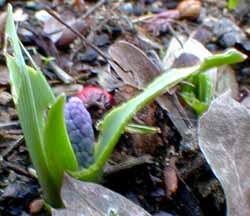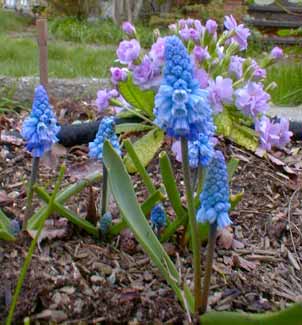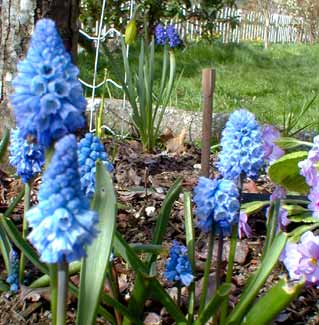
Azure Grape Hyacinth
"The grape Hyacinth is the favorite
spring flower of my garden —
but no! —
A minute ago the Scilla was!"
-Alice Morse Earle
(1851-1911)
(1851-1911)
Muscari azureum is a fat, sky-blue grape hyacinth, with its pyramid of little florets more rounded than most species of grape hyacinths, forming quite a remarkable muscari that certainly deserved its Award of Garden Merit, given in 1928 by the Royal Horticultural Society.
Each little blue flower that makes up the dense raceme has a darker blue stripe, & each is an open bell, rather than having the typical "pinched mouth" that causes the bunch-of-grapes appearance of other species.
 This one therefore has much less of that "grape bunch" appearance & more of a flouncy-dress look. It is as though a common muscari got all dandied up in order to go cruising in a gay bar; that, or some bride selected gowns that truly humiliated her maids-of-honor.
This one therefore has much less of that "grape bunch" appearance & more of a flouncy-dress look. It is as though a common muscari got all dandied up in order to go cruising in a gay bar; that, or some bride selected gowns that truly humiliated her maids-of-honor.It's also a faintly two-tone flower. On top it has sterile flowers that are small & few. These are worn like a fancy little dunce-cap & are more obvious when the bloom has aged. The larger flowers of the raceme are numerous & darker.
Its overall uniqueness explains how it could be that before taxonomists settled on Muscari as its genus, this unusual flower was placed variously in the genuses Hyacinthus, Bellevalia, & Pseudomuscari.
Azure Grape Hyacinth is a native from Eastern Turkey to the Caucasus Mountains, & has been in cultivation in Europe since the Victorian era. It will naturalize in almost any well-draining sunny area. It is rather small, at only four to six inches height, smaller than other small muscaries; but the blossoms are startingly bright for the latter portion of March & all of April, so it makes a huge impact despite its tininess.
 In cooler zones it might not bloom until after M. botryoides has already started, though here on Puget Sound M. azureum is just about the first of the muscaris to flower, though in our garden it beats out M. latifolium & M. botryoides by scant days.
In cooler zones it might not bloom until after M. botryoides has already started, though here on Puget Sound M. azureum is just about the first of the muscaris to flower, though in our garden it beats out M. latifolium & M. botryoides by scant days.M. botryoides is in full leaf in September for a pleasing autumn & winter turf, whereas M. azureum produces butterknife-shaped leaves rather than the grassy leaves & they wait until winter's end to appear.
We planted ten bulbs along a morning-sun rockery ledge underneath a pin oak, burying the bulbs five inches deep, an inch apart, in Autumn. This was originally a full morning sun location, shadier as the day progresses, but as the pin oak grew & nearby shrubs got larger, the location became less sunny.
So far the little group of azure muscari has not failed to flower well despite increasing shade from the oak, but they have not increased in numbers either. I did not want to try to dig up the bulbs, but I did want to establish another drift in a more perfect location where they'd be much more apt to increase. So in October 2005 we planted about forty more bulbs in a much sunnier spot on a garden ledge, where it will flower through & above the ultra-short ground-hugging 'Corinne Tremaine' variegated wood speedwell.
The Azures want full sun either in the morning or the afternoon, but not both. In spring it wants moist well-drained soil; during its summer dormancy it likes droughtier conditions. The spot under the oak is perhaps better watered than these particular bulbs prefer, but being a rocky ledge it drains rapidly so the bulbs have persisted. The new bulbs in the more perfect location will be experiencing the droughty summer dormancy they much prefer.
In our garden, they first show themselves between the second or third week in February, when wee blue buds appear right at the ground, at the center of the starts of leaves. The first photo, top left, shows its earliest initial appearance. If this initial dot of blue is counted as sufficient color to mark the beginning of its bloom-time, it is long-flowering indeed, though of course the mature flower is still to come.
The second photo, snapped at mid-March, shows the flower scarsely any bigger than life size & already having considerable impact though not yet as fluffily mature as in the third photo from the third week of March. The lilac-pink flower behind the muscaris is Primula vulgaris 'Quaker's Bonnet'. In the third photo you can also spot a chopstick used as a marker; we save our chopsticks whenever we eat in Thai, Japanese, or Chinese restaurants, & use them to mark bulbs & other plants that might otherwise get dug up accidentally during dormancy.